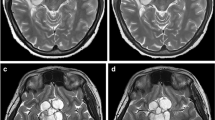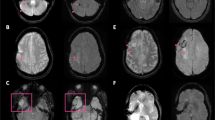Abstract
Background
T2-weighted fast spin-echo imaging (T2-W FSE) is frequently degraded by motion in pediatric patients. MR imaging with periodically rotated overlapping parallel lines with enhanced reconstruction (PROPELLER) employs alternate sampling of k-space to achieve motion reduction.
Objective
To compare T2-W PROPELLER FSE (T2-W PROP) with conventional T2-W FSE for: (1) image quality; (2) presence of artefacts; and (3) ability to detect lesions.
Materials and methods
Ninety-five pediatric patients undergoing brain MRI (1.5 T) were evaluated with T2-W FSE and T2-W PROP. Three independent radiologists rated T2-W FSE and T2-W PROP, assessing image quality, presence of artefacts, and diagnostic confidence. Chi-square analysis and Wilcoxon signed rank test were used to assess the radiologists’ responses.
Results
Compared with T2-W FSE, T2-W PROP demonstrated better image quality and reduced motion artefacts, with the greatest benefit in children younger than 6 months. Although detection rates were comparable for the two sequences, blood products were more conspicuous on T2-W FSE. Diagnostic confidence was higher using T2-W PROP in children younger than 6 months. Average inter-rater agreement was 87%.
Conclusion
T2-W PROP showed reduced motion artefacts and improved diagnostic confidence in children younger than 6 months. Thus, use of T2-W PROP rather than T2-W FSE should be considered in routine imaging of this age group, with caution required in identifying blood products.









Similar content being viewed by others
References
Thorpe JW, Halpin SF, MacManus DG et al (1994) A comparison between fast and conventional spin-echo in the detection of multiple sclerosis lesions. Neuroradiology 36:388–392
Engelbrecht V, Malms J, Kahn T et al (1996) Fast spin-echo MR imaging of the pediatric brain. Pediatr Radiol 26:259–264
American Academy of Pediatrics (1992) Guidelines for monitoring and management of pediatric patients during and after sedation for diagnostic and therapeutic procedures. Pediatrics 89:1110–1115
Sugahara T, Korogi Y, Hirai T et al (1997) Comparison of HASTE and segmented-HASTE sequences with a T2-weighted fast spin-echo sequence in screening evaluation of the brain. AJR 169:1401–1410
Mittal TK, Halpin SF, Bourne MW et al (1999) A prospective comparison of brain contrast characteristics and lesion detection using single-shot fast spin-echo and fast spin-echo. Neuroradiology 41:480–486
Ba-Ssalamaha A, Schick S, Heimberger K et al (2000) Ultrafast magnetic resonance imaging of the brain. Magn Reson Imaging 18:237–243
Ge Y, Korogi Y, Sugahara T et al (2001) Comparison between EPI and HASTE for ultra-fast MR imaging of the human brain. Neuroradiology 43:1046–1055
Pipe JG (1999) Motion correction with PROPELLER MRI: application to head motion and free-breathing cardiac imaging. Magn Reson Med 42:963–969
Forbes KP, Pipe JG, Karis JP et al (2003) Brain imaging in the unsedated pediatric patient: comparison of periodically rotated overlapping parallel lines with enhanced reconstruction and single-shot fast spin-echo sequences. AJNR 24:794–798
Wintersperger BJ, Runge VM, Biswas J et al (2006) Brain magnetic resonance imaging at 3 Tesla using BLADE compared with standard rectilinear data sampling. Invest Radiol 41:586–592
Alibek S, Adamietz B, Cavallaro A et al (2008) Contrast-enhanced T1-weighted fluid-attenuated inversion-recovery BLADE magnetic resonance imaging of the brain: an alternative to spin-echo technique for detection of brain lesions in the unsedated pediatric patient? Acad Radiol 15:986–995
Shaw DW, Weinberger E, Astley SJ et al (1997) Quantitative comparison of conventional spin echo and fast spin echo during brain myelination. J Comput Assist Tomogr 21:867–871
Ahn SS, Mantello MT, Jones KM et al (1992) Rapid MR imaging of the pediatric brain using fast spin-echo technique. AJNR 13:1169–1177
Author information
Authors and Affiliations
Corresponding author
Rights and permissions
About this article
Cite this article
Vertinsky, A.T., Rubesova, E., Krasnokutsky, M.V. et al. Performance of PROPELLER relative to standard FSE T2-weighted imaging in pediatric brain MRI. Pediatr Radiol 39, 1038–1047 (2009). https://doi.org/10.1007/s00247-009-1292-8
Received:
Revised:
Accepted:
Published:
Issue Date:
DOI: https://doi.org/10.1007/s00247-009-1292-8




